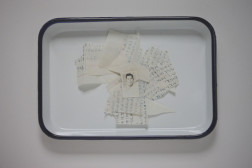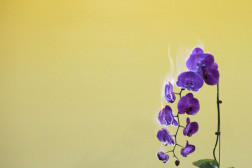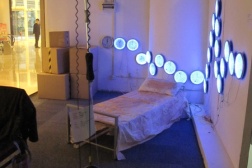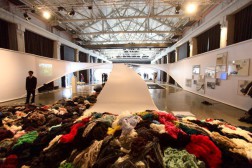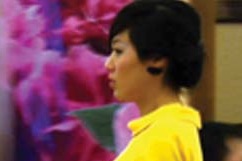
Solo Exhibition
The 2006 Solo Exhibition was very likely the most ambitious one that this group of artists has arranged in the last few years, even if the circumstances resulting from the exhibition varied drastically from what the group had anticipated. The event was made possible with the technical and logistic support of BizArt, the Dolan Museum and the Zendai MoMA. It was actually a combination of 38 solo shows by as many artists, each one curated utterly independently of the others, which, of course, made for a total of 38 catalogues, 38 invitations, 38 press kits, and 38 separate spaces clustered in a former industrial facility that had just been remodeled.
The exhibition covered an area of roughly 3,000 square meters. Approximately eighty people contributed to the making of the event, including the artists, the aforementioned institutions and students. Each artist was in charge of his or her own solo exhibition, from the form and content to the design of the invitation and the catalogue. Perhaps as a result of the long prevailing “silence,” imposed by Chinese censorship from 2000 to 2006, the critical content of several of the works on display was quite direct, and at times their visual impact was rather disturbing. The young Zhang Ding, for example, presented a photographic study of pornography in China; He An designed an installation about rape. The works were labeled as “unstable” by the authorities, and in the presence of over a thousand visitors, the exhibition was closed down by cutting off the electricity, just ten minutes after it opened.
News of the event was not made public. On the one hand, the local press was silenced; on the other, we ourselves chose not to enlist the international press, considering that by working in China, and intending to work in China in the future as well, we had to play by the rules and accept all the consequences of breaking them. We undertook multiple negotiations with the authorities to try to rebuild our relationship with them. As soon as the exhibition was shut down, the three organizations behind the event were indicted, and a number of the artists had to make themselves scarce for weeks. Some of them went away, others faced the local authorities, and still more were forced into hiding.
Why Solo Exhibition?
by Alexander Brandt
Why, here in Shanghai, did we decide to make a group exhibition in which the artists all made their own independent shows? Before answering this question let us take a step back and look at what has happened elsewhere. The history of modern art presents us with about one hundred years of group-exhibitions, each introducing an innovative concept that encompasses the pursuits of its participating artists. What made these exhibitions so powerful was that by identifying a new common trend and building a platform for it, these exhibitions were able to create synergies among artists and offer the audience an experience where the combination of the shown artworks was greater than the sum of the individual works. However, when the art-world finally became disillusioned with the modernist belief in progress and idealism, and rang in the clean-sweep of postmodernism, artists gradually wandered from the high art values that still dominated the minds of art historians.
Artists since the 1980’s have not only abandoned commonly pursued high art goals and commonly agreed on values, they have also abandoned their commonness altogether. Each artist has become a movement of his or her own. All of a sudden it has become very difficult to identify valuable synergies between artworks. Their differences had long since outgrown their similarities. Despite this changing environment, most exhibitions continued to impose master-concepts in an attempt to generate a synergy, but these themes often rang like empty slogans. And where there were absolutely no content-orientated unifying themes available, geographical or formal subjects were being used.
What about China then, and particularly Shanghai? Is the situation comparable? Let us look at Shanghai and its short history of artist-organized exhibitions. In 1998, a group of young artists opened the door to an independent contemporary art exhibition, Jin Yuan Road 310. At that time, making an exhibition in and of itself was enough to excite the art-world in Shanghai. Later in 1999, when this was no longer sufficient, the artists turned to theme-orientated exhibitions like Art For Sale. By making direct reference to a common experience–in this instance, life in Shanghai–it was still possible to create a synergy among artworks. However, when such subjects became constraining rather than unifying, exhibitions that followed retreated to a formal consensus to build the exhibition concept. Examples are Wu Shi Ren Fei, 1999, a photography-only exhibition; Twins, 2002, where each artist had to create a twin-pair of works; On-Paper, 1999, with paper being the imposed medium; Tao-yan, 2004, painting; and in 2004 62761232, at with the exhibition was literally delivered to the door-step of anyone who called the specified courier-service.
On other occasions, when confronted with the obvious lack of any striking synergy, a new attitude developed. In this vein, attention was no longer paid to the relationship among the artworks. Restrictions were no longer imposed on the subject or form of the artworks. Obviously this evolution didn’t happen according to any scripted plan, but simply occurred according to what was being felt in that moment. Useful Life, 2000, serves as an example, it was an exhibition with no real theme, just artworks. That same year, Young Artists, is another example; every artist was given the freedom to do what they wanted, with the only constraint being that the work shouldn’t look like their typical style. After One-by-One, a long term series of solo-shows, individual artists were finally being given the room to build and conceive his or her artwork according to their own perceptions and desires. But then of course, One-by-One was not a group show. While the necessity for change was felt, the problem of how to make a group show had still not been conceptualized.
Before conceiving Solo Exhibition, we went through a long period of conceptual research, trying to revive the flame of exhibitions that were held together by a strong and commonly felt concept. The first proposition was The Last Exhibition, where each artist would make his last artwork. Later China was proposed, a concept that played with the sensitive subject of cultural identity and affiliation. Heated discussions were held, artist lists were established, spaces were researched, and money raising was debated. Yet in the end the balloon just didn’t take off. It always felt like the air was leaking out, just as it was about to blow away. Something was fundamentally wrong. The question arose, what if there is no flame to revive? What if there no longer was a commonly recognized issue that could create this synergy among artists.
If the objective still is to make a group show a stimulating experience, then how? We eventually ended up considering that the thing in common, the thing we had been so desperatley looking for, the synergy that links together all artworks in a potential Shanghai group-exhibition, was exactly the absence of all commonness. The thing we have in common is that we have nothing in common. Shanghai exemplifies the urban planning catastrophe, a place where kitsch and high-culture coexist, where masses operate according to a value system in constant flux. These singularities, while being afflicted with negative connotations, emerge as a spring to energetic, constraint-less innovation. The artists celebrate total individualism, and independence from a prescribed value-system. They don’t care about the classic past. They don’t care about displaying western expectations. They don’t care about art-history. They don’t care about anything, but what it is they want to do.
The art-world has dumped its value references, and so has China. There are no longer any collectively shared values and binding truths. Solo Exhibition is conceptualizing the antithesis to a group exhibition. It is the logical milestone, that naturally responds to what is commonly felt among artists here. This exhibition will not ask the artists to perform the ritual adaptation of their work to a master-concept, but rather challenge the artists to pronounce themselves independently. There will be no limiting framework and at the same time no supporting framework either. The participating artists are solely responsible for the organization of their space: they themselves select the title of their exhibition, create their own catalogue, decide the design of their own invitation and are individually representing their exhibition in front of the media.
To create a clear architectural distinction between each solo show, the floor space in between is raised to half a meter. The audience will walk on a bridged level and descend into each of the spaces to see exhibitions that have nothing to do with one another. The whole will be just as heterogenous as we are. After leaving this celebration of egocentric individualism, we could ask what is this, “I only care about what I want” attitude, all about. Is it a benediction, a threat to society? A future trend or a temporary fashion? Of course there will be no answer–only speculation. But one thing is for sure: it is here and now.
